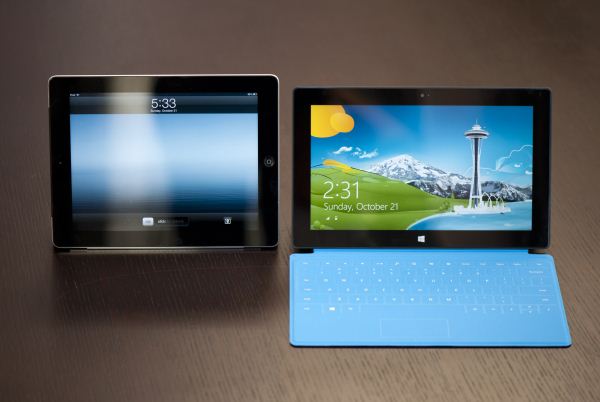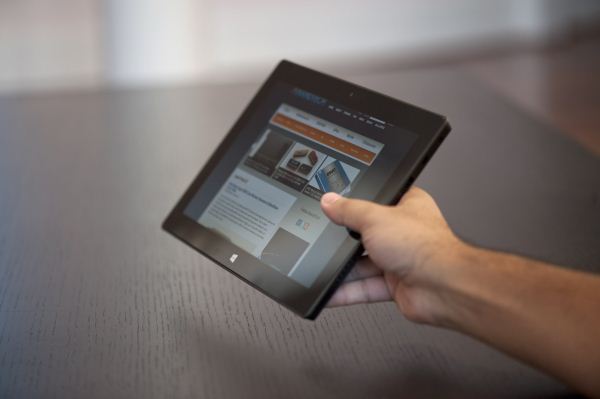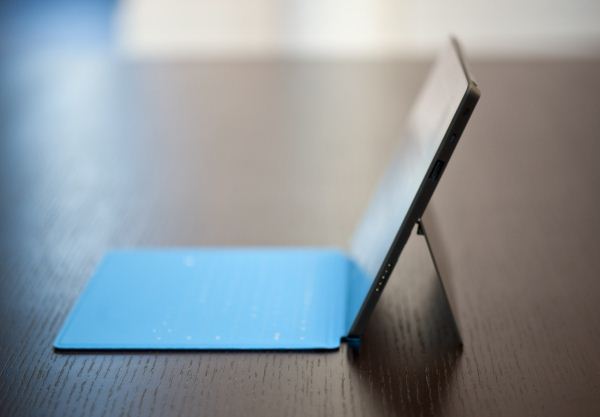Microsoft Surface Review
by Anand Lal Shimpi on October 23, 2012 9:01 PM EST- Posted in
- Tablets
- Microsoft
- Mobile
- Surface
- Windows RT
Surface: Simply Put
Surface is very well built and extremely well designed. It’s easily among the best built products I’ve had the opportunity to handle, and definitely puts a lot of earlier attempts from far more experienced companies to shame. I wouldn’t say that it looks better or worse than the iPad, it’s simply different. I talked about perspectives earlier, Microsoft’s perspective on tablets is a bit more utilitarian than Apple’s and Surface’s design reflects that reality.
Where the iPad is curvy and without any IO expansion, Surface is squared off with 22-degree beveled edges. The iPad features a light aluminum finish while Surface contrasts with its dark Magnesium surface. Not better or worse, just different.
Surface is both larger and heavier than the iPad, both design decisions on Microsoft’s part to built a device that could better deal with Windows RT’s multitasking capabilities as well as make room for a comfortable typing area when used with one of its two keyboard covers.
The added weight is offset by superb internal weight distribution. Microsoft claims a lower moment of inertia by more evenly distributing weight inside Surface’s chassis. I don’t know that I’d consider Surface light but it is very comfortable to carry around. It’s not quite like porting around a pad of paper, but carrying Surface feels very natural.
The focus on weight distribution results in a device that is honestly comfortable to hold in tablet mode and very comfortable to carry around. The more squared design of Surface actually makes in hand feel more like a book than the iPad, which was an early goal for the device.
The chassis is built out of an injection molded Magnesium, which gives it a very different feel to most machined Aluminum or plastic tablets we’ve used in the past. Microsoft calls this process VaporMg (vapor-mag) and I have to say that I’m pleased with the outcome. Surface’s finish is smooth and lacks the same texture that we’ve come to expect from machined Aluminum. The device feels very durable and doesn’t seem to scratch or scuff easily, although I didn’t purposefully try to mar my review unit over the past week. Striking a balance between robustness and light weight is very tricky business when building mobile devices, Surface easily falls on the robust side of the scale without feeling overly heavy. I never felt that the device was too fragile.
The power of Surface is in its flexibility. Microsoft’s talents not as a software developer nor as a parts assembler are what make Surface great here, rather its design and manufacturing intuition. I would’ve expected Surface to come from a company that had much more experience in designing and building tablets and PCs, not from a company that’s traditionally known for putting stickers all over them.
Surface’s flexibility comes from three areas: the tablet itself, the integrated kickstand and the optional Touch/Type covers. In tablet mode, Surface is Microsoft’s take on the new wave of tablets. It delivers the same intimate content consumption experience that you’d get from other tablets but with the added benefits of Windows RT, such as improved multitasking and better task switching.
Surface also features an integrated kickstand, also made out of the same VaporMg process as the rest of the chassis.
Microsoft wants you to be able to quickly transition between notebook, tablet and display modes. It’s rare that I see a goal so well executed. Surface really masters the art of quick transitions between all three modes. I can be in word, typing out this review and quickly switch to a tablet mode where I’m browsing the web with the keyboard cover folded neatly behind the display. If I need to respond to a comment or answer an email, I can just as easily switch back. The kickstand is a necessary part of enabling these quick transitions, and it does its job well.
There’s only one side of Surface that has a cutout for you to easily flick the stand out from its resting place. The kickstand’s range of motion does take some getting used to. It’s spring loaded enough to pop out at good velocity (and strong enough to pinch your skin nicely if you close it on a part of your finger by accident). When deployed it positions the top of Surface away from you at a 22-degree angle, matching the bevel of Surface’s edge.
With a fixed angle of deployment the kickstand doesn’t always deliver the best viewing experience, although it’s usually good enough. The kickstand is perfect for desk use and even for using while reclined on a couch or even in bed. Where it does fall short is if you’re hunched over Surface on an airplane in coach without a lot of room to move the device away from you. In those situations you’re going to find that you’d wish the kickstand could open at a wider angle.
Microsoft is particularly proud of the acoustics and feel of the kickstand. In my experience I felt the kickstand actuated nicely but I don’t know if I’d go so far as to draw the luxury car door comparison. The best way I can put it is the kickstand never feels cheap and doesn’t rattle, it works and gives you the confidence that it’ll always work and not just break after half a year. It’s not often that I find a substantial moving part on a mobile device that I feel is more functional than gimmicky. Surface’s kickstand is definitely a job well done.
The third element of Surface that makes it a very flexible device is also responsible for the splash of color in the design that gives the otherwise business appearance a consumer twist. I’m talking about Surface’s Type and Touch Covers.



















235 Comments
View All Comments
jonyah - Tuesday, October 23, 2012 - link
That's where Surface Pro comes in. I think pretty much everyone would go for the Pro if it were available day one, which is why they've delayed it. Core i5 power (though less battery life) and x86 compatibility will make it a winner.....i think.I hate windows 8 for any normal machine, though it may be nice in a tablet form. I'm still waiting to be able to actually play with one first.
Zink - Tuesday, October 23, 2012 - link
$900+ is too much for most people. Ultrabooks are amazing but sales numbers are poor. Sales are much higher on $500 laptops and tablets. The Surface Pro is also a bigger fan cooled device that won't offer the same battery life so the experience suffers there.I think the killer devices are the Atom tablets at $500. x86 and faster than ARM but with the same form factors and price. Asus is pricing at $600 for their VivioTab RT with battery/keyboard dock. I'd like to see 1080p too but maybe another product or manufacturer.
shompa - Wednesday, October 24, 2012 - link
*hint* Ultrabooks sell well: Macbook Air.PC can't compete with Apple at the same price. Today's ultrabook are priced same as Apple (but usually with larger SSD and/or faster processors).
That is like a BMW priced same as a Skoda. Most people buy BMW.
That is why Android tablets can't compete at the same price point as Apple.
That is Surface will have a hard time.
The rumour where that the Surface would cost 199 dollars, and that would have been a hit. (But OEMs would hate MSFT even more). The 199 price would work since people have to buy apps from MSFT paying them 30% on each app. MSFT subsidise Nokia phones and Xbox360 when it was release. This is a tactic they used many times before.
And I believe that Surface will head that way. We will see a 50% price cut within a year.
I really want to use Surface. But from the looks of it: its a nerd/corporate machine. The usual MSFT market. Wont sell 100 million.
Hoekie - Wednesday, October 24, 2012 - link
Why? Get the cheaper 32GB version and pop in an SD card if price is an issue.Looking at the first reactions from people around me, Surface will be hot selling.
Office + Multiuser + Light + batterytime+ touchcover+port connections. Actually a no brainer. In fact the 32GB no cover version is sould out everywhere including Germany.
vision33r - Tuesday, October 23, 2012 - link
MS will have to give away Xboxes again to move this after the initial batch of early adopter orders are filled.N4g4rok - Tuesday, October 23, 2012 - link
Care to elaborate?MadMan007 - Tuesday, October 23, 2012 - link
translation: "I don't like MS and/or Windows 8 but don't have anything useful to say."LancerVI - Tuesday, October 23, 2012 - link
That was an extremely accurate translation. Bravo to you sure and thanks for the lulz.shompa - Wednesday, October 24, 2012 - link
MSFT have given away many Xbox360 so sell Windows phone. MSFT have done similar things many times spending tens of billions to take market share and then start to charge more money.Surface wont fly of the shelves. After the first batch MSFT needs to do something. Giving away Xbox360 is cheap for them
Later we will see a price cut. Up to 50% within a year. It will also be intresting if MSFT follows Apples "1 year" bump cycle or a more aggresive "pc/Android" bump cycle. iPad4 have 400% faster CPU and at least 800% faster GPU. A6 is as fast as Intel per clock cycle. (and yes: I understand that A6 is dual core and intel is quad + clocked much higher. But the fact is that A6 is as fast per clock cycle. ARM will replace X86)
Surface is not a mass market product. It cant compete with the sub 300dollar 7 inch tablet market. It will have a hard time compete with Ultrabooks and Ipads.
A MSFT product that cost the same as an Apple product have never sold.
Surface +
-its more of an PC. It could be the only computer
-Office
-Kickstand
-the covers are great
Surface -
Pricey 600 dollars for ancient hardware.
maximumGPU - Wednesday, October 24, 2012 - link
i would love to borrow your crystal ball some day!